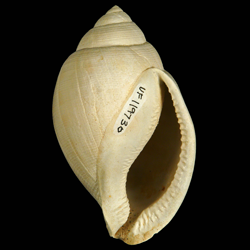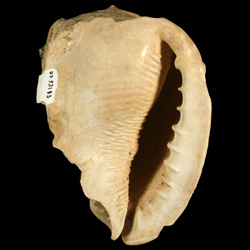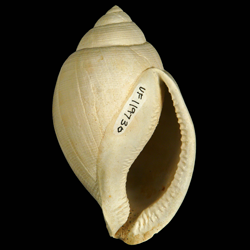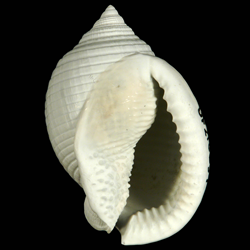
Cassidae

- Phylum: Mollusca
- Class: Gastropoda
- Order: Littorinimorpha
- Family: Cassidae
Overview
Common name: Helmet shells
Key morphological features: The Cassidae are medium to large gastropods with robust, globose, low-spired shells that often also have prominent color patterns. Exterior sculpture consists of one or more spiral lines of knobs, fine spiral cords or striae, or a cancellated pattern of axial ribs crossed by spiral grooves. Many species also feature prominent varices. The aperture ranges from narrow and slit-like to crescent-shaped in outline, and is surrounded by teeth in many species that range from small and closely spaced to large and separated. The labrum is thickened and most species feature a prominent parietal callus. The anal canal is variable between species, but most species have a short siphonal canal, often twisted dorsally. Source: Davies, A.M. 1971. Tertiary Faunas Vol. 1, second edition. New York: American Elsevier Publishing Company, Inc. 571 pp.; Tunnell Jr., J.W., Andrews, J., Barrera, N.C., Moretzsohn, F. 2010. Encyclopedia of Texas Seashells. College Station: Texas A&M University Press. 512 pp.
Geological range: Upper Cretaceous to Recent (Davies, 1971).
Geographic distribution: A distributional map for modern Cassidae may be accessed from OBIS. A distributional map for ancient Cassidae may be accessed from the Paleobiology Database.
Diversity: There are 97 recognized living species of Cassidae and 12 genera (WoRMS database, unvetted). The Paleobiology Database recognizes 27 fossil genera and 267 fossil species of Cassidae (unvetted).
Paleoecology: The Cassidae are semi-infaunal, carnivorous, marine gastropods, most of which live in shallow, sandy habitats, although some species can be found on hard substrates as well. The Cassidae prey on echinoderms such as sea urchins and sand dollars. Source: Tunnell et al. (2010).
Phylogenetic status: Unknown.


